First Impressions: Sarajevo
 A view of the city in the valley. All photos by Emily Abernathy-Jones unless otherwise noted.
A view of the city in the valley. All photos by Emily Abernathy-Jones unless otherwise noted.
Just beyond the well-traveled lands of the Mediterranean lies the Balkan city of Sarajevo, the capital of Bosnia, rich with history, culture, and food. Fathom reader and contributor Emily Abernathy-Jones shares a fascinating overview.
SARAJEVO, Bosnia and Herzegovina – It has been nearly twenty years since Bosnia has seen war. The country is still recovering, and its battered reputation doesn't even begin to hint at the simple, rugged beauty of the country or its cosmopolitan capital city's enchanting blend of Ottoman exoticism and European elegance.
Bosnia has not only been an important stop on the trade passage between West and East for centuries, but has been at the center of a tug-of-war between competing empires seeking to expand their influence by conquering the Balkans. Rome versus Byzantium, Catholicism versus Orthodoxy, Hungarians versus Turks, Ottomans versus Austro-Hungarians. The struggles of the day have all clashed head-on in Bosnia. And while it's sometimes flattering to be fought over, in practice this has meant a steady parade of conquerors who have set up shop in Bosnia and tried to advance their aims by yoking locals to their cause. Architectural, cultural, and religious imprints have been left behind by each wave of empire-building aspirants.
It has left a mark on Sarajevo: From one end of town to the other you can literally step through centuries of history, from cobblestoned Ottoman stronghold to Austrian nation to Socialist Yugoslavian republic and back to modern, independent Bosnia and Herzegovina.
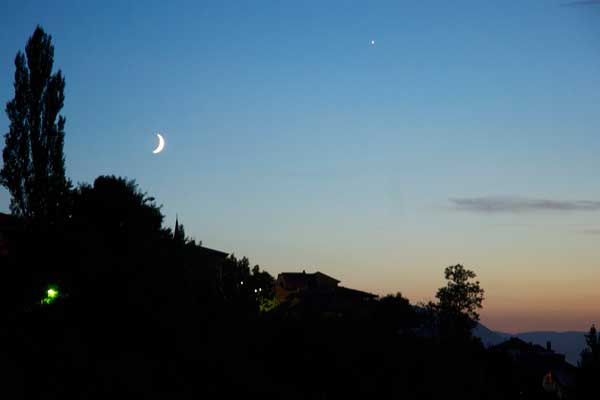
Sarajevo in the moonlight. Photo: danbri / Flickr
I had a few days to spare on the back end of a trip to Belgrade last winter, and I pounced at the chance to spend them in Sarajevo, a scant half-day's drive from Belgrade and similarly close to various Croatian coastal towns. Beyond dim memories of the 1984 Winter Olympics, I hadn't given Bosnia much thought until the winter after I graduated from college when, on an icy afternoon in late 1995, I found myself on an overheated New Jersey Transit train, engrossed in a dense foreign affairs article on the Bosnian War that I had brought along to pass the time. Just trying to keep track of the primary players — Bosnian Serbs, Bosnian Muslims, Serbian Serbs, Croatian nationalists — required an outsized amount of mental bandwidth, and by the end of the ride the margins of my magazine were heavily annotated with notes and question marks as I tried to make sense of the tangled allegiances, historical grievances, and nationalist ambitions in the region that lead to the shocking atrocities of war. Thankfully, within the framework of the Dayton Accords signed in December of 1995, it was coming to a long-overdue end, halting the nearly three-year siege and the worst genocide on European land since the Second World War.
Needless to say, the scars are still there, though they are healing. In the meantime, Sarajevo absolutely merits a trip. The compact city in a valley in the Dinaric Alps can be seen in a couple of days, making it the perfect stopover or addendum to your European travel plans.

The Latin Bridge where Gavrilo Princip assassinated the Archduke Ferdinand of Austria in 1914, ushering in the start of the World War I.
HITCH A RIDE
First, don't rule out the idea of being driven to Sarajevo, especially if you are coming from Belgrade. I am normally a go-it-on-your-own kind of girl, but on the advice of our hotel in Belgrade (Townhouse 27, perfect in every way), who warned of multiple unmarked turns along the four-hour drive to Sarajevo, my husband and I hired a driver. Zoran Zupanc of Taxi Exclusive turned up in a sleek Audi and navigated all those unmarked turns (yup, not a sign in sight, not even in Cyrillic), stern border officials, and hairpin curves with ease. Which means you can sit back and enjoy the passing scenery. Rural Bosnia looks a lot like Vermont, in that people emerge out of nowhere on switchback roads to fill buckets from taps connected to mountain springs.

Townhouse 27. Courtesy of Townhouse 27.
GET A LAY OF THE LAND
When you arrive in Sarajevo, drop your bags and get going! There's no time like the present, and you're going to wish you had stayed longer. Grab a map so you know what you're seeing, but given that Sarajevo is hemmed in by mountains and divided by the Miljacka River, it's pretty hard to get lost. If you are going uphill, you are heading out of town; if you cross the river once, then you need to get back over at some point.
STARTING OUT
A good place to start is at the Sebilj, or "pigeon square," in the Baščaršija, the old Ottoman bazaar. This is Sarajevo at its most beguiling and charming. From here, looking at the Islamic domed roofs and down the small stone-paved alleys flanked by doll-size, wooden storefronts and craftsman's workshops, it's easy to imagine life as medieval trader bunking down with a donkey caravan during the earliest days of Ottoman rule.

Sebilj, aka Pigeon Square. Photo: Jennifer Boyer / Flickr
If you want to kick off your stroll with some Bosnian cuisine in your belly, duck into Buregzinica Dzinovic (Baščaršija, 24), just opposite the main public fountain in the square for a cheap and cheerful helping of burek, the delicious square of meat pie wrapped in phyllo dough and served with a yogurt drink on the side.
From here, ask someone to point you toward Male Daire, the charming hidden courtyard not far from the Sebilj, hung with colorful, oversize lanterns. Take note of the location in case you want to come back later for tea or to smoke flavored tobacco from a water pipe at one of the resident shisha cafés.
Take a walk down Kazandžiluk Street, home to the city's coppersmiths. While there are many things to admire — copper plates, tea sets — by far the most interesting are the piles of leftover artillery casings now upcycled into vases etched with flowers. Shockingly, some are big enough to hold a small sapling – a sobering reminder of the pummeling this city endured. One particularly interesting object on display at a shop at the far end of Kazandžiluk is a homemade rifle fashioned from not much more than pipes and a spring, a sort of plumber-turned-munitions artisan object. Ballpoint pens with tips made from sniper bullets emptied of their powder are another unconventional souvenir. I felt vaguely uncomfortable taking home a former instrument of destruction, but this trench art seeks to diminish the impact of war by transforming symbols of aggression into totems of pacifism.
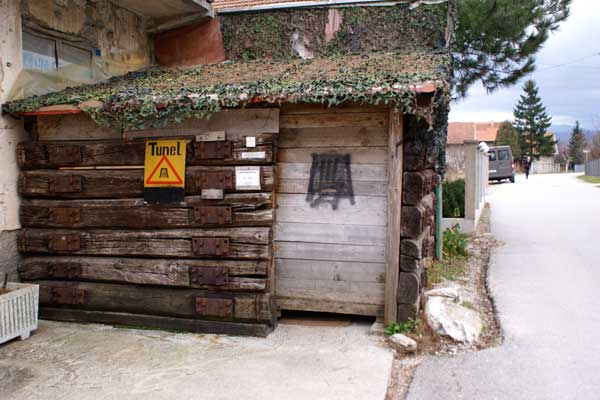
Entrance to the Sarajevo War Tunnel Museum.
LIVING HISTORY
If you only do one thing, book a tour of the Tunnel Museum by stopping into the Sebilj Tourist Office (Saraci, 58). The tunnel, dug by Sarajevan citizens in 1993 from underneath a private home in the Bosnian controlled territory of Butmir, ran underneath the UN-protected Sarajevo airport and exited in the Sarajevo neighborhood of Dobrinja. For the duration of the nearly 1,200-day siege, during which Sarajevans had only intermittent food, water, and electricity, the tunnel was the city's lifeline and the sole means of entry for food and munitions. Many citizens threaded their way through the infamous "Sniper Alley" and risked their lives in order to cross the tunnel to purchase supplies from the black market in the hills beyond Butmir. Though most of the tunnel has collapsed, a small section remains open to walk through. The house is still occupied by the same family, and it's hard to imagine that life will ever return to normal for them.

Combined with a walk thought the tunnel, our guide's sober reflections on his own experience and the current realities in Bosnia impressed on me the complicated realities of the legacy of war. He was only seven years old when the war broke out. His father managed to secure a spot for him and his mother on the last flight out of Sarajevo but stayed behind for the duration of the war to fight against neighbors who had once been friends. His father survived, and the family is together again in Sarajevo, but our guide made it clear that the post-war division of Bosnia into two entities (the largely Bosniak and Croat Federation of Bosnia and Herzegovina, and the predominately Serbian Republik of Srpska) has made economic and political progress difficult. Each faction has its own ministries and parliament and a presidency that rotates among the three ethnicities, all overseen by the Office of the High Representative, whose job it is to monitor compliance with civilian aspects of the Dayton Accords. Though Bosnia is rich in natural resources, there is no consensus about how to use them. Unemployment is high, and opportunities for college graduates are limited. Our guide was the second person to express nostalgia for the stature, quality of life, freedom of movement, and industrial production under the former Yugoslavia.
Head south for a look at the Saborna Crkva Orthodox Church on Trg Oslobođenja and the old men playing chess in the square, then continue down toward the river for a stop at the famed Latin Bridge, where Serbian nationalist Gavrilo Princip assassinated Austrian Archduke Franz Ferdinand on June 28, 1914, prompting Austria to declare war on Serbia and sparking World War I. The one-room museum on the corner is devoted to a recounting of that day.
FOOD FOR THOUGHT
Back in town, leave the tourist office and continue west along the main pedestrian thoroughfare of Saraci and Ferhadija into the Austro-Hungarian part of town, taking in the Gazi Husrev Begova Mosque and the Roman Catholic Cathedral. Stop at the fluorescent-lit Egipat (Ferhadija, 29), where women in white aprons serve syrupy baklava pick-me-ups.

The author's husband surveys the sweets shop.
If, like me, you are hell-bent on discovering a place hrough its food, you must put aside the notion of how many times you ought to stop for a snack and head to one of the two Zeljos near each other on Kundurdžiluk in the Baščaršija. It is there that you should order ćevapi, finger shaped lamb-and-beef sausages that are served with a large round of pita bread and chopped raw onions.

Ćevapi. Photo: Kurman Communications, Inc / Flickr
At this point you have two options — either head back to your hotel for a nap (just because you can!) or forge on and take a wander uphill past the large cemetery to Žuta Tabija for a view out over the city. You'll get a much better sense of how vulnerable it was to attack when you see it from above, strung out in the valley below. If you are really feeling like an overachiever, wander uphill from the fortress into the Vratnik neighborhood above. Up here, war damage is much more visible. Along the narrow, twisting silent alleys, houses are heavily pockmarked from the shelling, and massive old buildings like the Jajce Army Barracks are heavily damaged, unrepaired, and abandoned. Though the city is being continuously reconstructed, work began in the city center and will move out to the surrounding areas as funds become available.

Finally, make it your night's mission to enjoy a hearty dinner at Dveri (Prote Bakovica, 12; +38-733-537-020), a small, cozy restaurant with a bantam kitchen bubbling with pots of Bosnian goodness and decorated with hanging ropes of garlic and dried peppers and, at least when we there in December, evergreen branches and small white lights. (Reservations recommended.) I can't recall ever having taken a restaurant recommendation from a tourist office, but thank goodness we did. Bosnian cuisine is surely the most underrated in the world, and Dveri is charming and Old World in all the right ways. My husband and I were so smitten with our dinner that we scrapped our plans to try beloved pub and brewery The Pivniča (Franjevacka 15; +38-733-111-222) in order to return to Dveri once more. Truly, I would fly back to Sarajevo for the night just to get my hands on a big mug of local beer and the delicate spirals of crunchy flaky dough which form the hat-shaped loaves of homemade bread. If I could also beg my way into a bowl of the shockingly good Dveri polenta with cheese, egg, and smoked meat, or a plate of fried sardines with potato salad, or stuffed eggplant well, then I'd be, as my husband and I joke, Dveri happy.

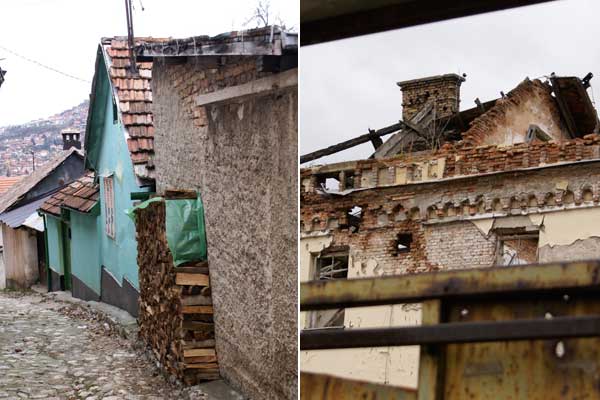
There's a lot of history in those walls.
PLANNING
Check out the local tourism website. For a survey on contemporary Sarajevo, read Boat magazine's Sarajevo issue. One note of caution: Though urban centers have been cleared of land mines, BiH is still contaminated with land mines leftover from the conflict in the 1990s. It is wise to stick to paved roads. Check with a local guide before venturing into the hillsides.
WHERE TO STAY
Hotel Central
8 Cumurija Street; +38-733-56-1800
If I were to go back, this is where I'd stay. It's central, looks nice, and is heavy on wellness amenities with a pool, spa, and gym.

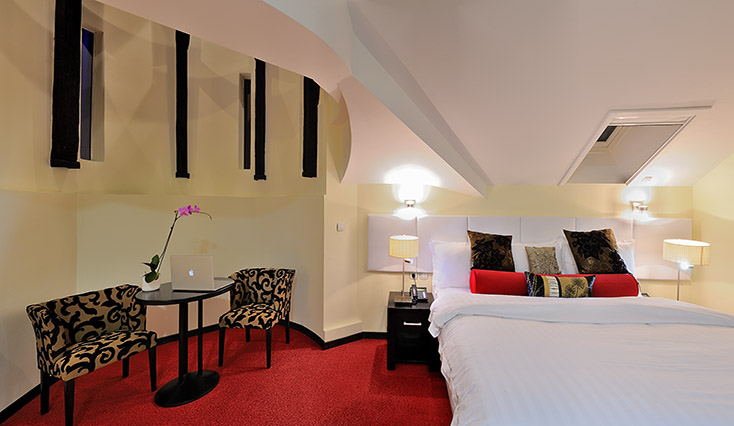
Hotel Central lobby and room. Courtesy of Hotel Central.
City Boutique Hotel
Mula Mustafe Baseskije 2; +38-733-566-850
Another option. Also centrally located, clean, and modern.
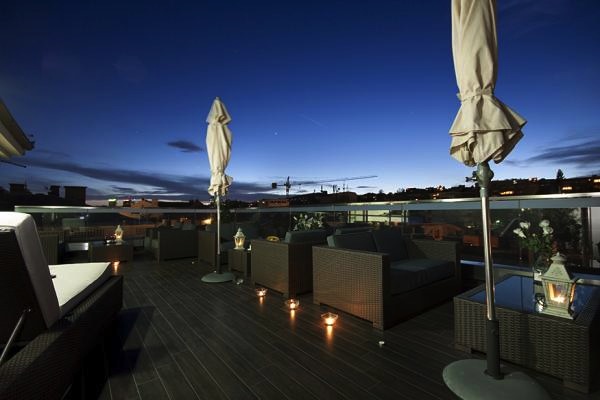
City Boutique Hotel. Courtesy of City Boutique Hotel.
FOR YOUR BEDSIDE TABLE
Zlata's Diary by Zlata Filipovic: An ten-year-old girl's diary of everyday life in Sarajevo during the first years of the siege.
Black Lamb and Grey Falcon by Dame Rebecca West: A travel journal wih commentary about Yugoslavia on the brink of the Second World War.
MORE ON FATHOM
Istria, the Better Italy
The Sommelier's Tour of Croatia
A Food Tour of Budapest
Inset Photos: Saborna Crkva Orthodox Church: Jennifer Boyer / Flickr; Dveri outdoor seating courtesy of Dveri.
